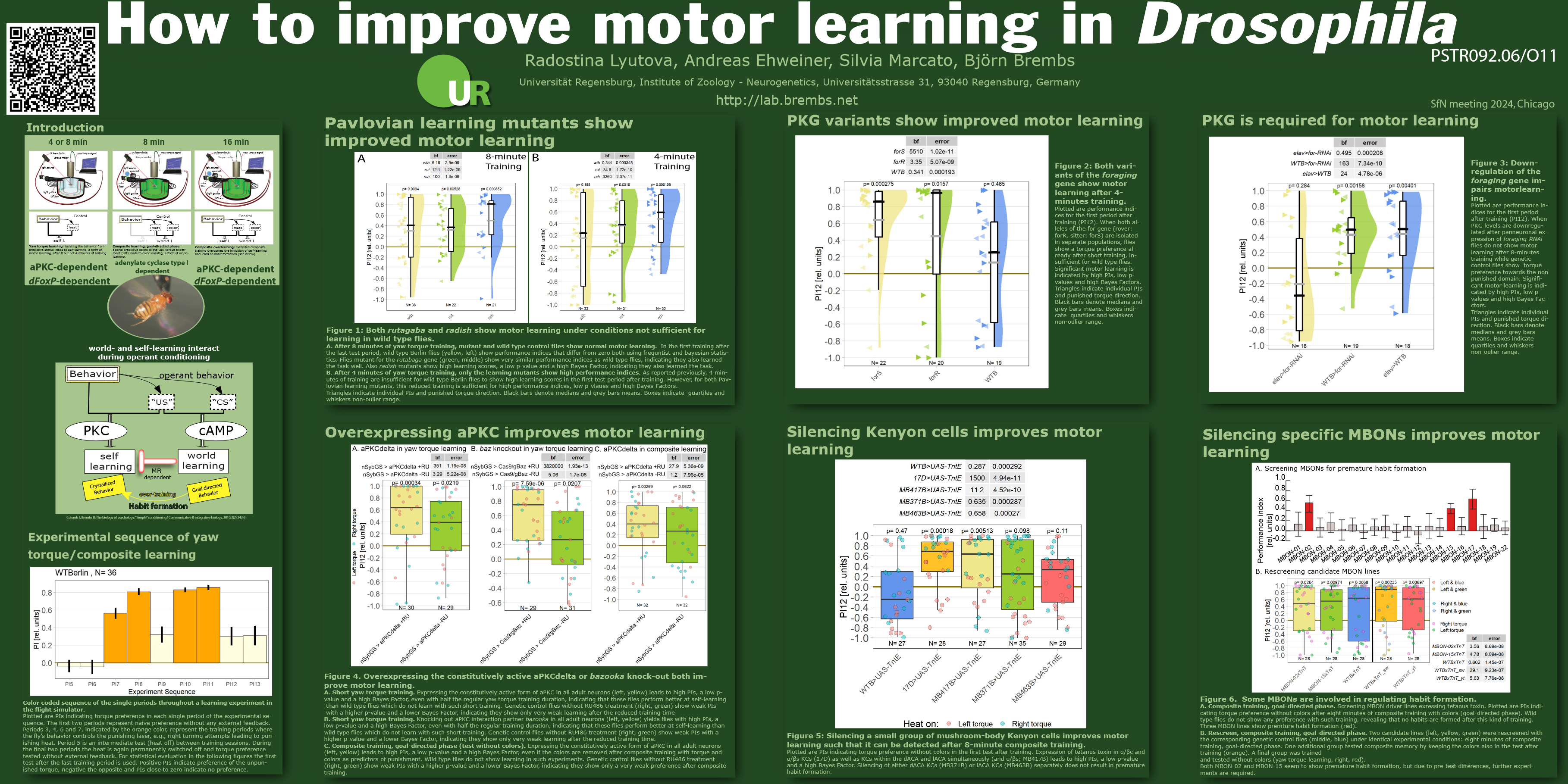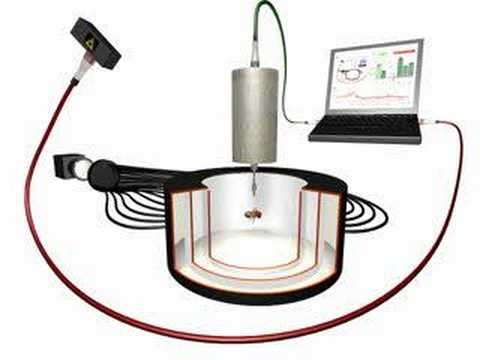I was very excited when our latest research paper came out, after all, I was confident our 30-year-long search for the sites of plasticity in the form of motor learning we study was coming to an end. In this work, we were fairly confident that underlying the type of learning we study was a novel form of plasticity in a very specific set of motor neurons in the ventral nerve cord of the flies we use for our research. The reason for our confidence was the convergence of several lines of genetic evidence:
- inhibiting all PKCs (protein kinase C) in motor neurons abolished motor learning
- knocking-out just aPKC (atypical PKC) in motor neurons also abolished motor learning
- knocking out aPKC in neurons that also express the gene FoxP abolished motor learning (and FoxP is also expressed in motor neurons and itself necessary for motor learning)
- knocking-out FoxP outside of the ventral nerve cord had no effect
In addition to these genetic lines of evidence, we looked at the expression patterns of the two genes we know are required for motor learning: aPKC and FoxP. #3 in the list of genetic evidence above suggests that aPKC is required in FoxP neurons, so we looked for neurons in the fly nervous system that co-express both aPKC and FoxP. The first finding was that there don’t seem to be any such co-expressing neurons in the brain, just in the ventral nerve cord. We (and by ‘we’ I mean our collaborator in Mainz, motor neuron expert Carsten Duch) identified some of those co-expressing neurons in the ventral nerve cord to be the steering motor neurons that control the muscles that position the wings during turning maneuvers. This last bit made us all excited: in our motor learning task, we train flies to make specific turning maneuvers, i.e., left or right turns, respectively. In our experiments, before we train the animals, they make just as many left turns as they make right turns. Then we train them to just do one kind of turns, such that, after training, the flies preferentially turn into the, say, right direction, if that was the side they’ve been trained to do. Finding that the motor neurons involved in these kinds of behaviors also expressed both aPKC and FoxP supported the genetic evidence that these neurons may be where the plasticity underlying the learning may reside. However, there aren’t the genetic tools available at the moment (they are being created as I type this) to specifically manipulate plasticity in just these neurons and no other neurons, so while all the evidence was pointing towards them, we couldn’t be quite sure, yet. There may be other neurons involved that we just didn’t have on our radar, yet.
There is another behavior that also involved these steering motor neurons and that is the “optomotor response” (OMR). Almost all animals show OMRs to moving stimuli: if you sit in a car or train and look outside to the passing landscape, your eyes will show the typical rapid movements (nystagmus) when trying to stabilize the moving image on your retina. Other animals move not just their eyes, but also their heads to stabilize the image, again others move their eyes, heads and sometimes also the rest of the body to, say, a rotating stimulus around them (or if they are rotated). Flies flying stationarily at a tether presented with vertical stripes moving around them either towards the left (i.e., counterclockwise, if seen from above) or right (clockwise, from above), respectively, will try to follow the stripes and generate turning maneuvers in the same direction: the optomotor response. It’s known that in order to execute these elicited turning maneuvers, there are neurons in the brains of the animals that send the information about the rotating stimuli directly to the steering motor neurons, bypassing all other neurons on the way. This means that they also bypass those neurons that are used to generate the spontaneous turning maneuvers we train the flies to perform in our motor learning paradigm.
Essentially, the only part of the nervous system, where the OMRs overlap with the behaviors we train are these steering motor neurons. This means that if these steering motor neurons are modified by our motor learning, as all the evidence described above suggests, we should se some modulation of the OMR after motor learning. Our paper shows the data where exactly such a modulation can be observed. So with this data we were fairly convinced that the plasticity we have been searching for in all these decades was indeed in the steering motor neurons. But we weren’t quite certain, yet. What was missing? Because we had so far only observed the modulation of the OMR in wild type animals, we didn’t know if the manipulations of the FoxP and aPKC that abolish motor learning would also abolish the modulation of the OMR. Now we finally also have that piece of the puzzle!
We again used the CRISPR/Cas9 technique to knock out aPKC on FoxP-positive neurons. These flies were first tested for their OMR before training, then subjected to motor learning of either left or right turning maneuvers, respectively, and finally tested for their OMR again. The genetic control flies that carried the same genetic constructs, but in a dysfunctional way so aPKC expression would not be affected were subjected to the same OMR-ML-OMR regime. The initial OMR between both groups was identical. The motor learning phase showed the same defiicit as we had observed with these flies in our paper:

The two control groups (blue and green) show a preference for the unpunished turning direction that is significant both in frequentist (Wilcoxon) and Bayesian (Bayes Factor, bf) statistics against zero (no preference), while the aPKC knock-outs (yellow) show no such preference. We replicated our finding that knocking-out aPKC in FoxP-neurons abolishes motor learning.
To compare the controls with the knock-outs, we pooled the controls and separately analyzed the OMR of those flies that were punished for left-turning maneuvers and those that were punished for right-turning maneuvers, respectively:

The control flies (above) show the modulation of the OMR that we had already seen in wild-type flies: animals punished for left turns showed a reduced OMR for left-turning stimuli and vice versa for flies punished for left turns. Quantifying this asymmetry shows us that flies punished on left turns show an asymmetry shifted to the right (i.e., positive values), compared to flies punished on right turns, who are relatively more negative (i.e., shifted to the left):

In contrast, this quantification in the knock-outs looks a lot more symmetrical:

If one now takes this measure of asymmetry and changes the signs such that positive doesn’t mean “right turns” any more, but “unpunished turning direction”, then we can compare the OMR modulation directly to the trained turning preference in a single figure:

The pooled genetic controls (A) show both a significant OMR modulation (blue, left) and a significant turning preference (yellow, right), while the aPKC knock-outs (B) show neither.
So with this data, we are now really quite sure that plasticity in steering motor neurons is one way in which this type of motor learning manifests itself in the nervous system.















